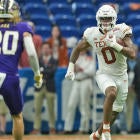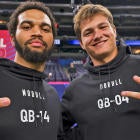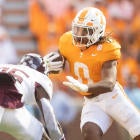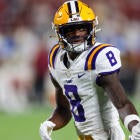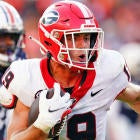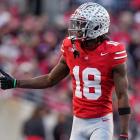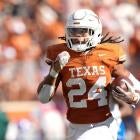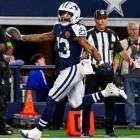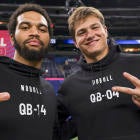There will never be another quarterback class like the Class of 1983. And we mean never.
That class produced six first-round picks, including three that will definitely be in the Pro Football Hall of Fame. Jim Kelly is already in the Hall and John Elway and Dan Marino are locks.
They are three of the six quarterbacks taken in the first round that year, with Todd Blackledge, Tony Eason and Ken O'Brien the other three. Of the six, Blackledge and Eason had disappointing careers, while O'Brien proved to be a solid starter if not at the level of the Hall of Fame three.
The Quarterback Class of 2003, two decades years later, is being hailed as one of those special classes -- even if it's not quite in the same class. There could be six quarterbacks who go in the first two rounds of this year's draft, with as many as five possibly going in the first round.
Headlining this class is Southern California's Carson Palmer, who should be the first player taken. Following him are Marshall's Byron Leftwich, Cal's Kyle Boller, Texas' Chris Simms, Florida's Rex Grossman and Louisville's Dave Ragone.
It is a class that has a lot of scouts and NFL personnel very excited. In 1999, there was another quarterback class that also excited, but proved to be more hype than production. That class produced five first-round picks. They were Tim Couch, Donovan McNabb, Akili Smith, Cade McNown and Daunte Culpepper.
Of those five, McNabb is now a star, Culpepper is a solid starter with a Pro Bowl on his resume, Couch has been a starter but not consistent, and the other two have been major busts.
Is this class as good as that one entering the draft?
"It could very well be," said Rams coach Mike Martz. "That's my opinion. I think it's a terrific class."
Terrific in that four or five could be taken by the end of the first round, but does it have three future Hall of Fame players? Only time will tell, but the reality is any quarterback class will be hard-pressed to come close to the 1983 group.
Ever.
With that, here's a look at the top six quarterbacks in this draft, using the 1983 players as a comparison.
Carson Palmer
The skeptics say that Palmer was only 16-16 as a starter before 2002, when he led the Trojans to a 10-2 record and won the Heisman Trophy. There had to be reasons, they say.
And there were. He was viewed as somewhat immature when he came to Southern Cal and he was forced to play in a couple of different systems. When Norm Chow took over as the offensive coordinator last year, Palmer responded by completing nearly 63 percent of his passes and throwing for 3,639 yards and 32 touchdowns.
"I don't think I was completely different," Palmer said. "He didn't come in and change my mechanics. He didn't change anything but the offense, but the system. He molded the system around me and the players we had."
Palmer is a prototype passer, with a big arm capable of making all the throws. There are some concerns that the simplicity of the Trojans offense has not prepared him for the NFL coverages he will see. Is he capable of making the reads and making the throw in time?
The one thing that scouts did find out about Palmer after the season is that he's a better athlete than they expected. His mobility and speed do not give the impression that he will be a statue in the pocket.
"I really see myself as a pocket passer, but I don't think I'm the type of guy that can only sit back in the pocket and throw the ball," Palmer said. "I can move around a little bit. Make as many plays as I can with my feet."
Where he'll go: First overall. Unless the Bengals move down, Cincinnati won't be able to pass up on the franchise quarterback.
Where he should go: First. He has all the tools to be a star in the league.
Compared to first quarterback taken in 1983: Elway was that player, and Palmer isn't in that league entering the draft. Elway had one of the great arms of all time and he was very mobile. He's on his way to the Hall as one of the best ever. Coming out of Stanford, he was a can't-miss player. Palmer isn't quite that.
Byron Leftwich
The main concerns about Leftwich are about his health. That's why his workout Monday in Florida was so vital to his draft status.
There have been mostly positive reports from that workout, especially regarding his health. Despite having a stress fracture in 2002, Leftwich still managed to play in every game. That led teams to worry his leg troubles could be an ongoing problem since he fractured it each of the past two seasons.
At his workout, he showed that he is healthy enough to play right away. At 6-feet-5, he was trimmed down to 236, which will help take some of the stress off his lower leg. It could also help his mobility, which is a weakness.
That same workout didn't produce great passing results. Some scouts who were there said he was rusty and he didn't look as good as he did on tape. Leftwich played mostly in a shotgun offense at Marshall, so he took all 70 snaps from center at the workout as teams want to see him get into his drops.
Leftwich was able to show that he could throw on the run, moving to the left and the right.
There is no denying he has the arm to make the throws, but the physical concerns may scare enough teams away. Leftwich has the numbers and the ability to be an effective NFL starter, but the questions are for how long and can his leg hold up?
Where he'll go: The Ravens, drafting 10th in the first round, would love to have him and may decide to take him in that spot.
Where he should go: The middle of the first round is about right. The injury concerns will scare some teams away.
Compared to second quarterback taken in 1983: When Blackledge came out of Penn State, he did so with a strong arm that impressed the Chiefs enough to use the seventh overall pick on him. Blackledge was a tough guy who lacked the accuracy needed in the NFL. He is a much better commentator than he was a quarterback. Leftwich has just as strong an arm as Blackledge and has a better feel for the passing game.
Kyle Boller
Some scouts insist his Pro Day workout last month may have been one of the best quarterback workouts they watched.
"He made every throw, looked as composed as could be and showed why he's moving up the draft board," said one AFC scout.
But those teams that are quickly moving him up should also not discount his college career. Boller came to California as the top quarterback recruit in the country, but struggled for much of his first three seasons.
Playing behind a bad line, he never looked like the passer he was in high school. But under new coach Jeff Tedford last season, Boller showed great improvement. Tedford is viewed as a quarterback guru, having worked with Trent Dilfer, Akili Smith and Joey Harrington when they were in college. Privately, Tedford has said that Boller has the tools to be better than all of them.
Tedford corrected a flaw in Boller's throwing motion, which led to his most productive season. He threw 29 touchdowns, with two games of five each, one against Washington.
Boller has become the rave of the offseason, his arm strength wowing scouts at his workout when he threw a ball through the goalpost from 50 yards out while kneeling. He also ran under 4.6 in the forty at the combine, which shows how athletic he is for a 235-pound player.
Some scouts who have studied his tapes aren't so convinced that he is first-round material. They point to the fact he completed just 53.4 percent of his passes last season, although he did have his share of drops.
"When you watch him on film, you sure don't see it," said one NFC scout. "You see the arm, but not the accuracy. Somebody is either going to hit big or miss big on this kid."
Where he'll go: Late first or early second round. If some team gets sold on his workouts, he could go higher.
Where he should go: Second round. He did not play like a first-round pick in college.
Compared to third quarterback taken in 1983: Coming out of Miami, Kelly was the third quarterback taken in 1983. Kelly had a powerful arm and a linebacker mentality. Boller has those same qualities, although he may be more athletic than Kelly was.
Rex Grossman
He is a tad short by NFL scouting standards, standing just over 6-1, but Grossman has a powerful arm and a compact, quick release that will make him a solid NFL quarterback.
At Florida, he threw for 9,164 yards and 77 touchdowns as he played in the pass-happy offense. In his first two years, playing under Steve Spurrier, Grossman was outstanding. He didn't look as sharp playing in the new system last year, but he still had his moments.
The new system, coupled with a below-average offensive line and receiving group, led to his struggles at times. The lack of a vertical attack played away from Grossman's strengths.
At both the combine and at his Pro Day workout, Grossman showed his arm was plenty strong enough to make all the throws. He did look much better at his Pro Day workout than he did at the combine, convincing many scouts that he will be a solid starter.
"If he was 6-2 or 6-3, everybody would be in love with him," said Spurrier, now the coach of the Redskins. "But he is 6-1 so nobody's sure about him."
Where he'll go: Late first or early second round.
Where he should go: Middle of the first round. If he were two inches taller, he'd go in the top 10. He has the tools to be a Pro Bowl player.
Compared to fourth quarterback taken in 1983: Coming out of Illinois in 1983, Eason was a drop-back passer who played in a pro-style offense, much like Grossman did his first two years as the starter at Florida. Eason proved to be a so-so NFL player, in part because he didn't make quick decisions. Grossman does.
Chris Simms
The son of former Giants quarterback Phil Simms, Chris Simms has been a regular punching bag for the media.
They love to point out that he was miserable in big games, which he was against many top-notch opponents, although some scouts point to the coaching in those games as a reason why. Simms did bounce back to have an impressive Cotton Bowl game in January to show that he can come up big when it counts.
Simms threw for 3,207 yards last year with 26 touchdowns and 12 interceptions. In the final five games, he threw 14 touchdowns and completed 64.2 percent of his passes.
Simms has a good arm, which he showed to the scouts in Mobile at the Senior Bowl. He also has a good feel for the game, having grown up around it all his life.
Scouts say one negative is that he seems carefree when it comes to football, that it doesn't seem that important. Simms also has some struggles with the blitz and his motion is too long.
A lot of that can be coached out of Simms, which is why he should be a player that continues to improve, something the final half of the 2002 season showed. The one thing that will never change is that last name, which will always bring a lot of pressure with it, pressure Simms will have to handle.
Where he'll go: Second round, with a team near the top likely taking him.
Where he should go: Middle of the first. He will be a better pro than Boller or Leftwich.
Compared to fifth quarterback taken in 1983: When the Jets used the 24th pick on O'Brien in 1983, it sent shocks through the draft headquarters. O'Brien was a virtual unknown out of Cal-Davis. The Jets loved his arm and his ability to read coverages, and this pick proved to be a good one. O'Brien was a good NFL passer. The only knock is the Jets used the pick with Marino still on the board. Simms is much more popular than O'Brien was, but he has similar arm strength although he may not have O'Brien's toughness.
Dave Ragone
When you mention Dave Ragone's name, the word that comes to mind is tough.
"He's got a running back's mentality back there," said one AFC scout.
That can be both good and bad.
Ragone entered the 2002 season as a potential high first-round pick. But after losing most of his receiving group from the year before and playing behind an offensive line that got him sacked one of every nine times he dropped back to throw the ball, Ragone struggled badly last season.
With his receivers struggling to get open and the line causing him to take a beating, Ragone began to take off at the first sign of pressure. He did finish his career as the all-time leader in rushing yards by a Louisville quarterback, but he didn't look like the same poised passer in the pocket.
This lefty looked more like Bobby Douglas than Boomer Esiason.
That sent the scouts back to more closely study his sophomore and junior tapes. Good postseason workouts, including at the NFL Scouting Combine, have helped his stock rise some. He does have a good arm, which the scouts like and that toughness will help him grow as he learns to stay in the pocket.
Where he'll go: Second or third round.
Where he should go: That's about right. Ragone does not have the feel for the passing game that the other five have.
Compared to sixth quarterback taken in 1983: That player was Dan Marino. Well, both of them are Italian. Nobody compares to Marino, who is arguably the best passer of all-time. Ragone does move around better than Marino, but when it comes to passing the ball, it's not even close. Marino lasted until the 27th pick of the first round because of some off-field questions, proving to be one of the draft's biggest steals.













